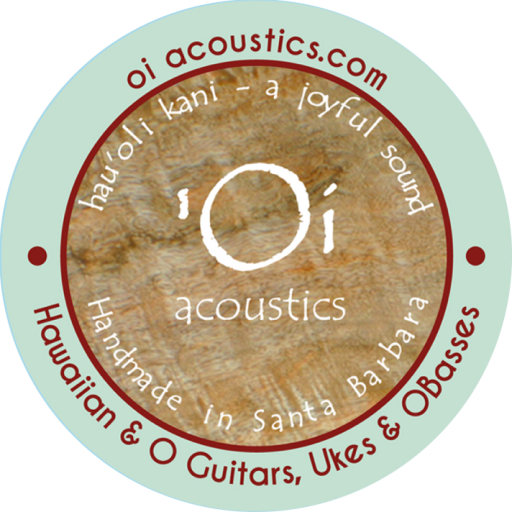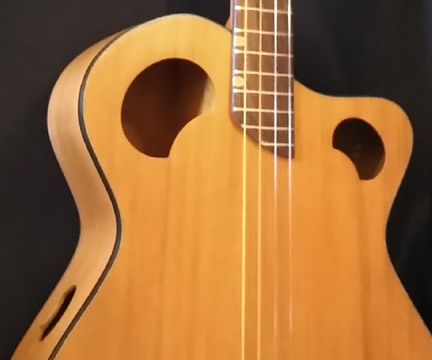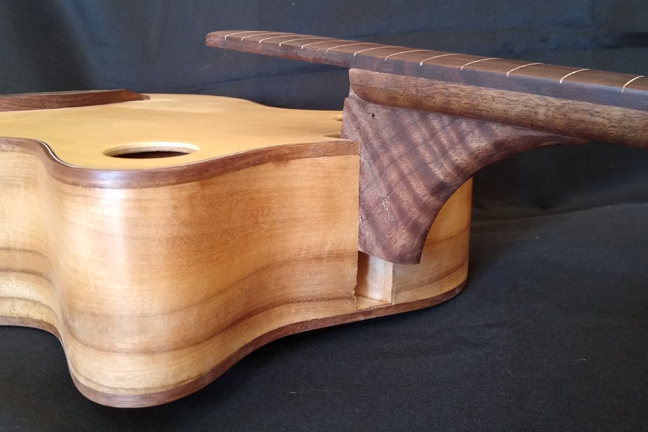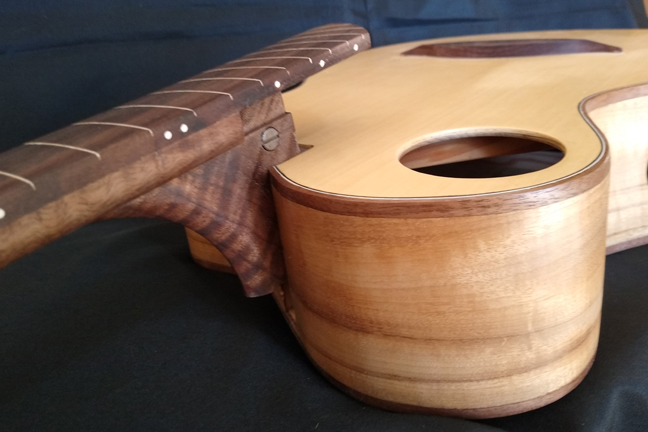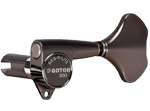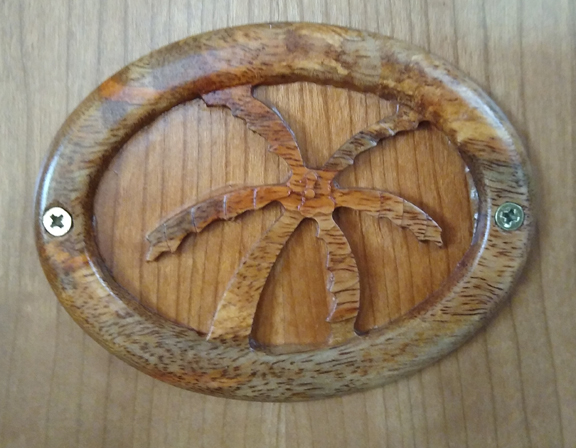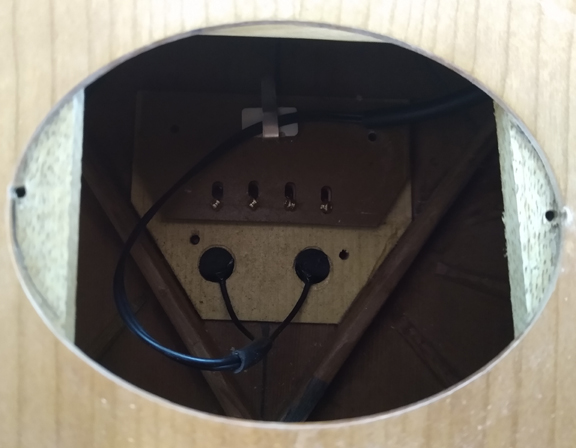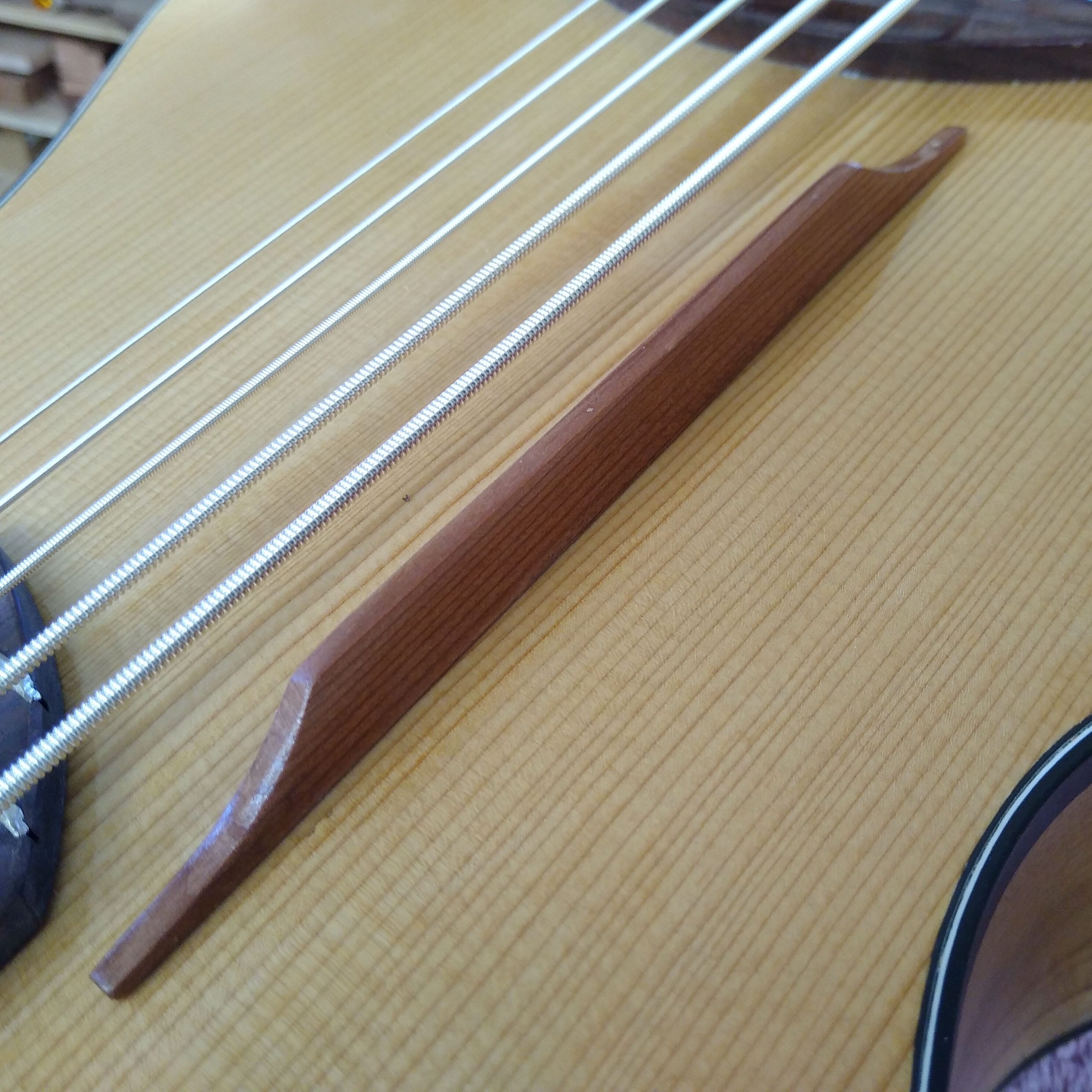Design Features
Body
'Oi instruments are designed with a consistent design aesthetic from the small concert ukulele through the full sized OM guitar: the fully curved body has no hard corners - the sides blend through the traditional cutout area for your ease of playing.
Soundholes
Cutting a big hole in the middle of a beautiful piece of tonewood, which in conjunction with the strings and bridgeplace are the engines of the body “speaker”, makes no sense as it reduces the available surface area. The effective free tonal area of an 'Oi soundboard is more efficient, having the same usable area as a larger standard center hole instrument. With a center hole, your hand mutes the sound and the instrument projects out and away from you – great for the audience but not for you. 'Oi allows you to hear the tonal quality of the instrument.
‘Oi expands that tonal potential by strategically placing two ported soundholes on the top's otherwise ineffective areas, which magnifies the sonic characteristics of the top. They add up to the same area as a central soundhole so that the instrument can breathe, but are proportioned to the Golden Mean so that the sound comes out at different locations in minutely different speeds, each with its own voice. These are in harmony and combine to create a multi dimensional surround sound that is uniquely rich and complex.
Neck and Fretboard
The compound curved neck and fretboard are prepared on a CNC to be dead accurate. This fully adjustable neck assembly is set to the body at 30 degrees, locking it in the X axis (across the width). It locates into a body channel with adjustable washers at the heel allow the neck to tilt in the Z plane to achieve a perfect angle to the body and string planes. The end of the fretboard is free and cantilevers over the body, purposely not touching the top so that it may resonate freely.
All wooden instruments have a propensity over time to slightly collapse due to string tension, which results in the action becoming higher. The 'Oi approach anticipates this, allowing a neck reset to be accomplished in minutes without damaging the instrument, and allowing you to maintain the right action for your style while maintaining the ideal saddle height for the strongest sound.
Tuners
'Oi tuning machines are made to order by Gotoh in Japan as they make the lightest, best made sealed precision tuners in a cool Cosmo Black color. The 30mm long posts are sized to maintain the proper string angle and not deflect; tuner stiffness while remaining easy and precise to tune is critical to the sound of an instrument. You will notice that when you tune an 'Oi and slide up to true pitch, all of sudden the instrument vibrates and rings with resonance at the correct frequency. It's an awesome sound.
All other instruments use Gotoh's high-quality sealed-gear SG381 tuners. These modern tuning machines have a 16:1 gear ratio for precise, accurate tuning for steel strings with good takeup for those stretchy fluorocarbon and classical wound. With a die-cast enclosure that is permanently sealed and lubricated for years of smooth operation, these are fitted with white pearl buttons which are easy to find on the stage. The weight per piece is just 33 grams (1.16 oz) which allows me to balance the instrument right at the body to neck joint, making for an easy to hold or strap instrument you can play for hours.
Weight
The mark of a good guitar is one that you do not want to put down. The weight of any Oi instrument, other than lap guitars, is a mere 3-5#. The smaller, lighter and more efficient size with high quality components make your playing much more enjoyable. And of course the more you play, the better you get.
The 'Oi Monopole String Plate
String material and sizing are a critical component for each instrument and are selected for balanced tension and response. How they attach to the top is the highest determinant of how how the instrument responds. Ideally the top should move up and down, but a typical bridge warps the top into a bi-pole wave that can result in phase cancellation and deformed tops. The strings on an 'Oi pinless through-top design attach to the bottom of a special 'Oi Monopole plate. This counteracts the bi-pole wave, and instead makes the top act as a monopole speaker similar to how a bass speaker travels back and forth as unit, or as a drum head moves with a rigid rim.
The 'Oi Shelf Saddle
Unique to ‘Oi, the IV generation saddles are cut on the CNC from black bone as a series of shelves perpendicular to the strings so that they stay in place without wandering. Rather than a simple straight line, which at best is a compromise of every string being slightly wrong, each locates on the saddle at its proper adjusted scale, which is critical to proper instrument intonation. I love the natural color variegation compared to synthetic materials.
Curved Nut Back
The backsides of the nuts have curved string slots to relieve the "pinchpoint" of a sharp corner at the fretboard side of the nut, which can wear strings out and break them. With a bone nut, you get a perfect balance of resonance and mass, which results in clarity and tone you just can’t get with other materials.
Access panel
Pickups
'Oi uses K&K Pure and LRBaggs iBeam transducer pickups as well as Lyric pressure zone mics, depending on the application. 'Oi does not use undersaddle piezo pickups, which are prone to fit and sound issues. The output plug reinforcement is located at 45 degrees on the underside of the lower bout so that it's out of the way of your strap; the pickup can be retrofitted at any time through the access panel without modifying the instrument in any other way.
Bass Thumbrest
‘Oi Wedge
The guiar bodies taper along the guitar length from the neck joint to the tail. This relieves the pinchpoint of the forearm on the body edge without compromising the top movement. Thanks to Linda Manzer for inspiring this geometry; her across-width wedge for Pat Metheny’s Pikasso and other large guitars opened up a world based on ergonomics rather than the doctrine of parallel.
The Instrument is Greater than the Parts
All of these elements exist not individually but in relation to each other. As with the forest, the components must work together to create a whole that is greater than the sum of its parts, and which has a voice, a vibration, a sustain and a sympathetic resonance all of its own which you will tune into.
...the art of resonance...
Tod S
Tucson, AZ
Having been a long time student of resonance in my professional life, and more recently as a guitarist, I am really impressed with what I am hearing from my new guitar. Your design combined with the choice of woods and other materials has produced an end result that fits perfectly with what I refer to as "the art of resonance". Very unusual and unique. Seriously, I have not heard this from other guitars!"
'Oi handmade instruments are available to be made to order.
Some may be in stock, but more likely they are custom made with a delivery time of 3-6 months.
In stock demos are available at a 40% discount - send a request for what you are looking for.
That is the 'Oi experience - try it; you'll like it!
